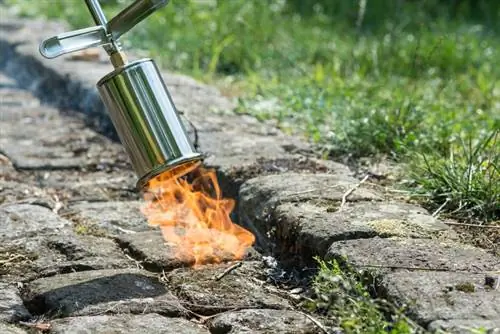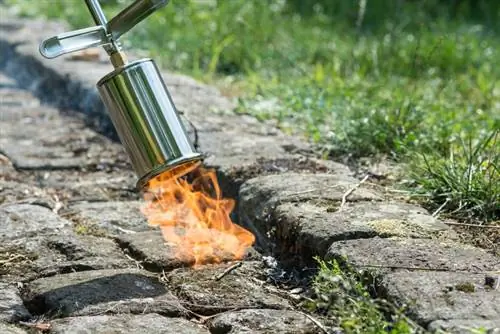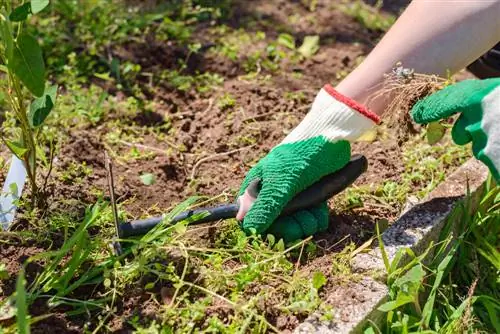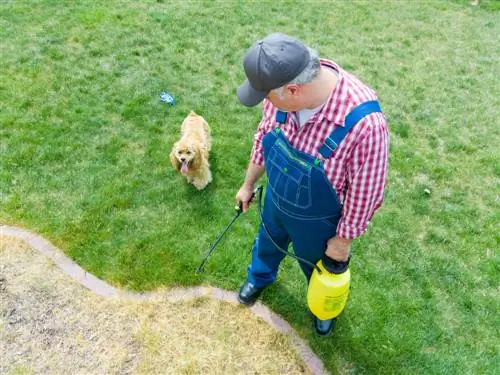- Author admin [email protected].
- Public 2023-12-16 16:46.
- Last modified 2025-01-23 11:21.
Cucumbers, tomatoes, zucchini, beans and many other types of vegetables, as well as strawberries and sweet fruits in general, grew splendidly this summer and produced abundant yields, although they vary regionally. However, garden owners have also had to keep the weeds at bay, as there has been real greenhouse weather in many places in the last few weeks. There are many ways to make life difficult for weeds, but the most effective, but also the most physically demanding, is and remains the manual method of pulling them out by hand, as long as the garden area is of a manageable size.

How to successfully eliminate weeds from joints?
To effectively remove weeds from joints, you can pluck them out manually, lay weed fleece, seal joints with synthetic resin, use vinegar-s alt solutions (attention: controversial), use flame devices or use high-pressure technology and hot water.
However, our aim today is not to explain to you the quickest way to get your beds weed-free, but rather to get to the bottom of the annoying little plants between paving slabs, paving stones and concrete joints.
Weed fleece as a mechanical growth barrier
Little or no trouble with dandelions, pigweed, creeping couch grass etc. Garden owners who, when laying out their garden paths or the rest area with a barbecue area painstakingly paved with mosaic stones, have already thought about the most energy-saving way to combat weeds before construction. The right laying technology, suitable materials and the targeted introduction of barrier layers can have a huge prophylactic effect and make it more difficult for weeds to establish themselves. The use of rot-proof and frost-resistant weed fleece, which is commercially available in rolls or in the form of pre-fabricated tarpaulins, has proven particularly useful. When purchasing polyester sheets, the following criteria should be taken into account:
- Material thickness at least 150g/m2;
- High light tightness and water permeability;
- Tear resistance;
- As dark a color as possible to ensure light deprivation;
- Free from chemical binding agents.
Sealing the joints with synthetic resin
The more irregular the joint pattern becomes after laying paving slabs or the very popular quarry stone slabs made of natural stone, the more the formation of weeds is encouraged. Wide joints promote growth significantly, and if there is also accumulating moisture, the wild growth of weeds can hardly be controlled. With paving joint mortar, concrete and natural stone paving as well as clinker paving can be quickly, permanently and very inexpensively sealed against all kinds of regrowing weeds. They are self-compacting, have high abrasion resistance, resist de-icing s alts and frost and also reduce the risk of accidents caused by protruding edges of the pavement.
S alt & Vinegar - (not) a home remedy for unwanted greens!?
Neither of the two notorious home remedies will curb weed growth in the long term and certainly not without negative effects on neighboring plantings. In addition, according to the Plant Protection Act, vinegar-s alt solutions are prohibited in the garden or not, as the Oldenburg Higher Regional Court recently decided. However, it should be noted:
- S alt: Cannot be mined on sealed surfaces such as driveways, terraces and paths, gets into the groundwater and causes serious problems for the waterworks.
- Vinegar: The cell membranes of other plants in the area are severely affected depending on the concentration of the vinegar solution, so the use of this home remedy is considered questionable.
Total attack on weeds with flame devices
And the flamethrowers or, to put it more appropriately, the weed burners are very trendy and do a great job with their hot gas flame of around 1,000 degrees. Available in various sizes, as gas bottle or small cartridge devices, they work with a propane-air mixture and fight weeds right down to the roots. Important to know: You don't have to keep it on for so long until the plants burn. A short and bold swing of the lance at the target object is enough, as the cell walls required for growth are completely destroyed, including any existing seeds, so that your weeds will die within a few days. Progress can be made relatively quickly in combating relatively young plants where the risk of new weeds growing back is very low. Relatively simple and, because of their design, very light weed burners (€39.00 on Amazon) are available from specialist retailers for under €20.00. Important when burning: The devices should only be operated in weather with as little wind as possible, as the risk of fire is quite high, especially if there are dry leaves or grass cuttings in the immediate vicinity.
Fight weeds with high pressure technology & hot water
Although this environmentally friendly method is still relatively unknown, hot water technology is convincing more and more garden owners. The reasons are obvious:
- Effective and time-saving weed destruction;
- No chemical agents required, the hot water simply seeps into the sand;
- Very precise work possible, so neighboring plants are not affected;
- Floor coverings (natural stone, clinker, etc.) are also cleaned at the same time;
- Low noise pollution with user-friendly workflows;
- Long-lasting effect due to the 98°C hot water;
The principle of operation of thermal weed control
Basically, the biological properties of plants are taken advantage of: their protein molecules are slowly but surely broken down at a temperature of 42 degrees Celsius. Garden owners know this when the lawn or certain vegetable crops begin to turn brown during mid-summer weather. Hot water also has the advantage that it can reach the roots because it has high thermal conductivity. However, success in removing weeds with hot water does not come immediately. With this technology, three to four applications are required in the first year before the plants die completely. After that, the amount of work is reduced by about half.
Equipment for private users
While municipalities began using hot water steam technology on a large scale and mounted on special vehicles several years ago, garden owners who are concerned about cleanliness have to make do with smaller devices. Market leader Kärcher has brought system solutions of different sizes onto the market that are also suitable for private users. The steam cleaners from Batavia, which are available for around 150 euros, are significantly cheaper, but no less efficient.






